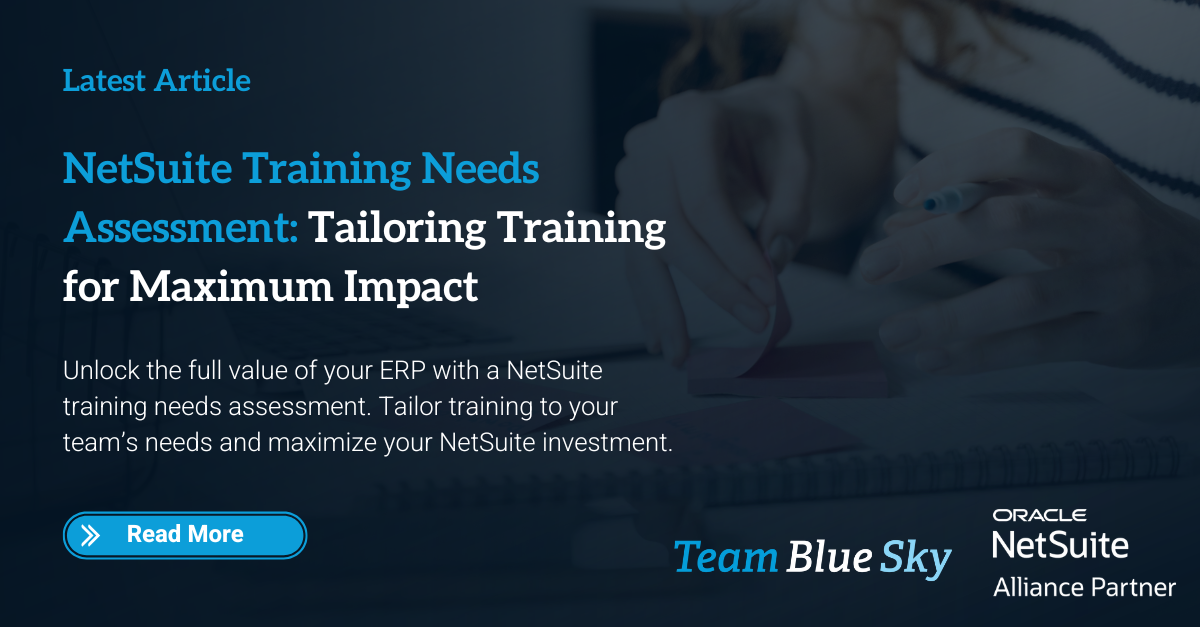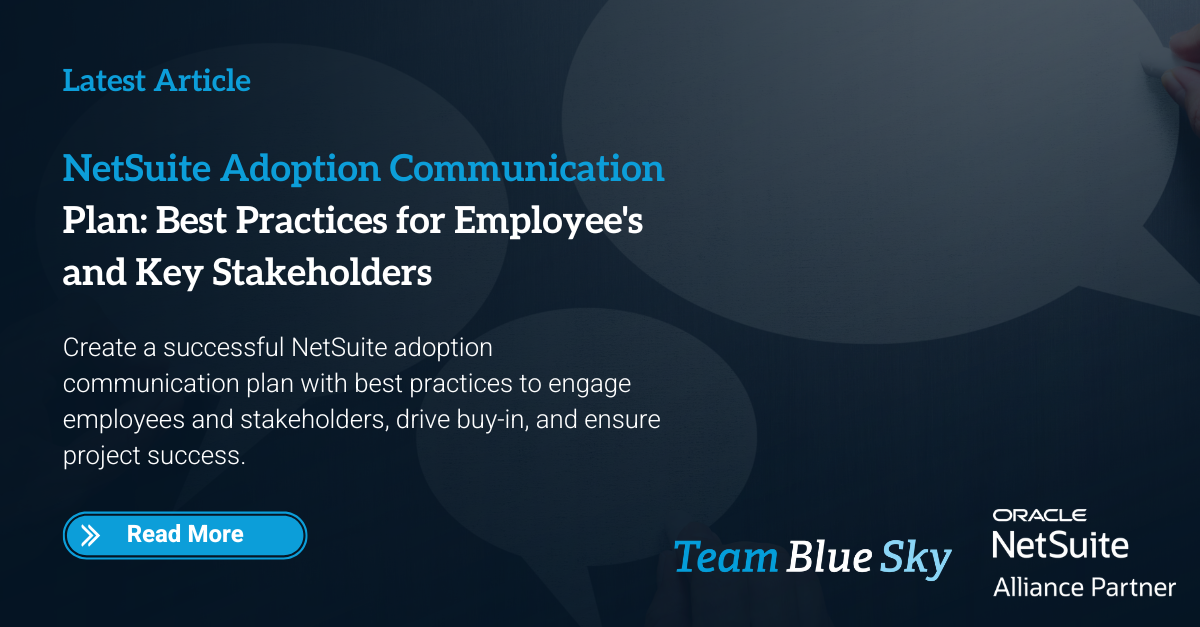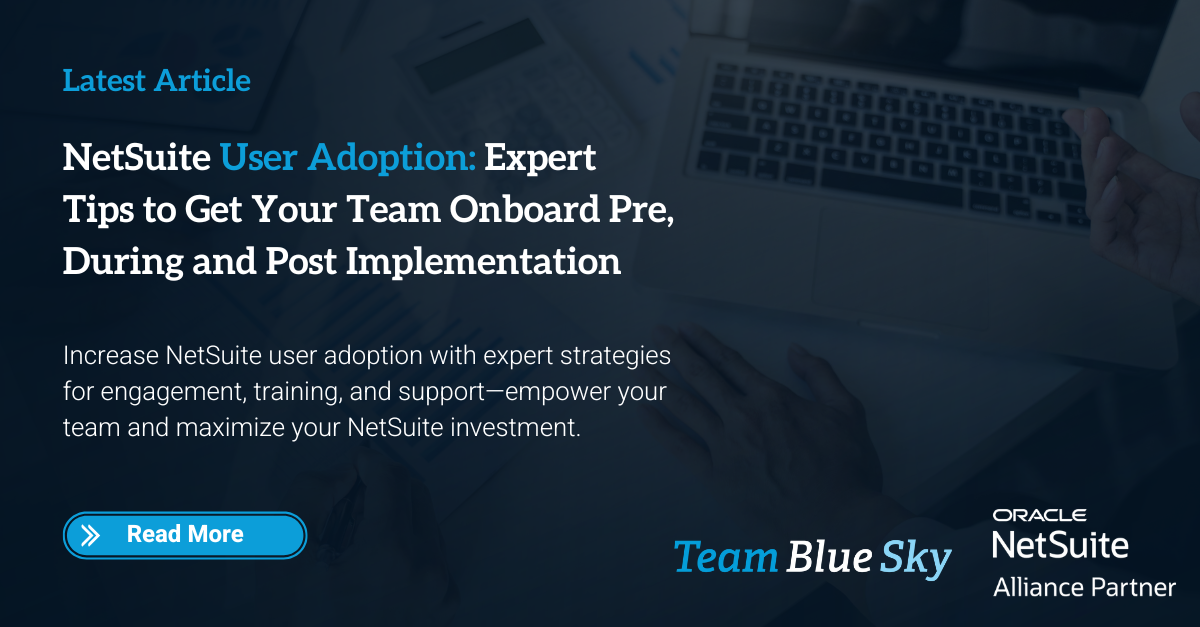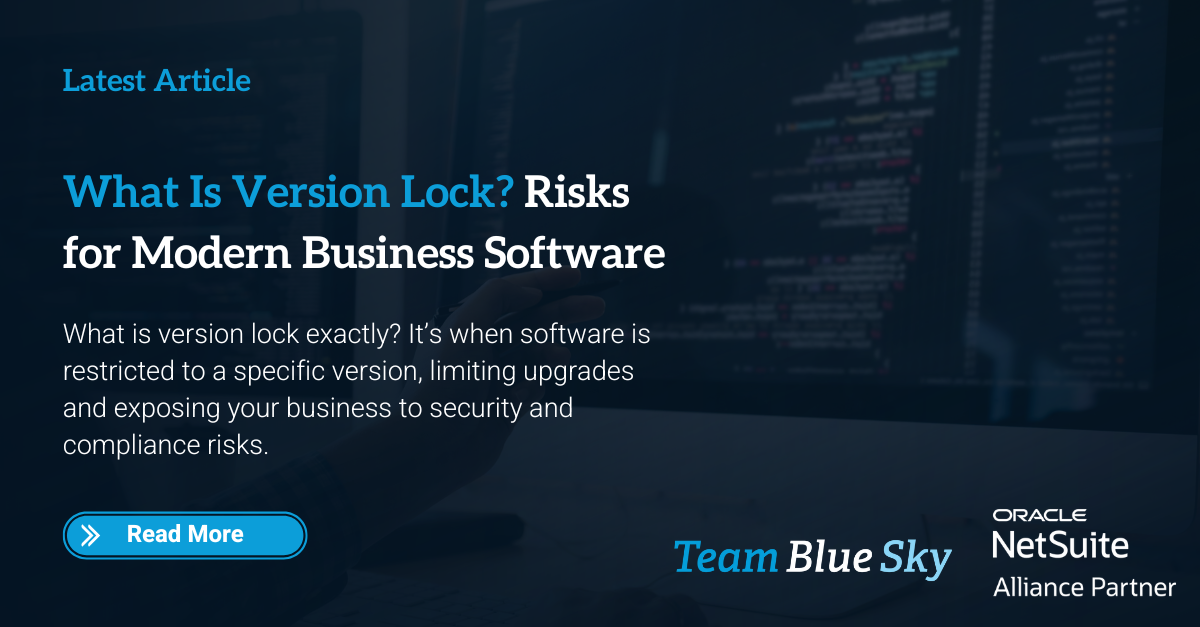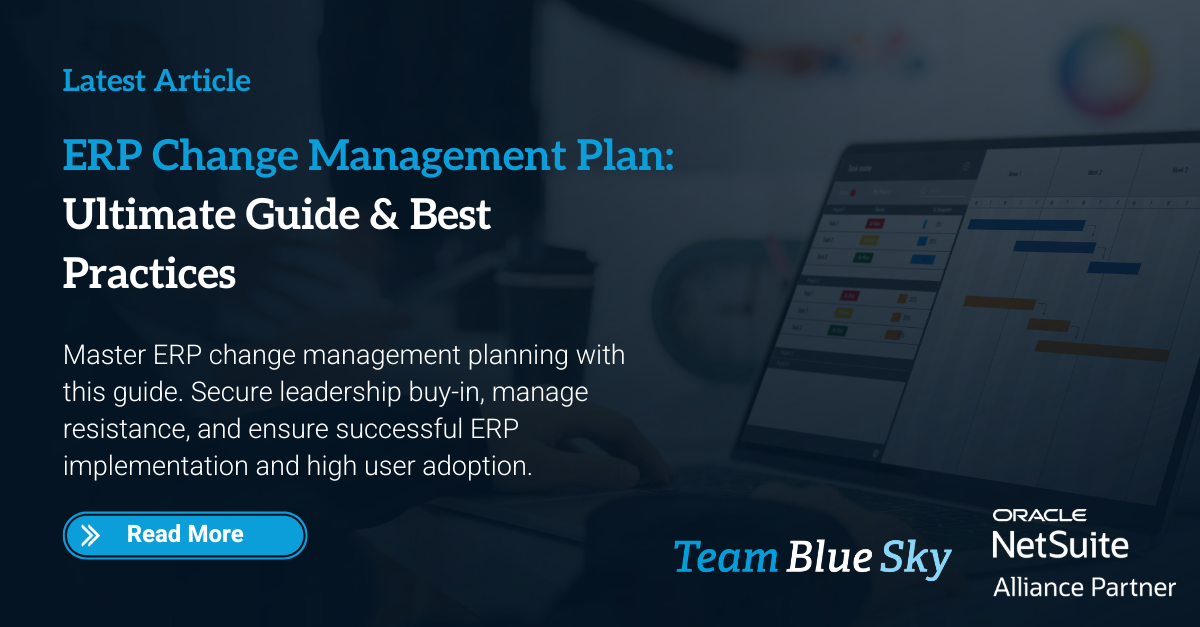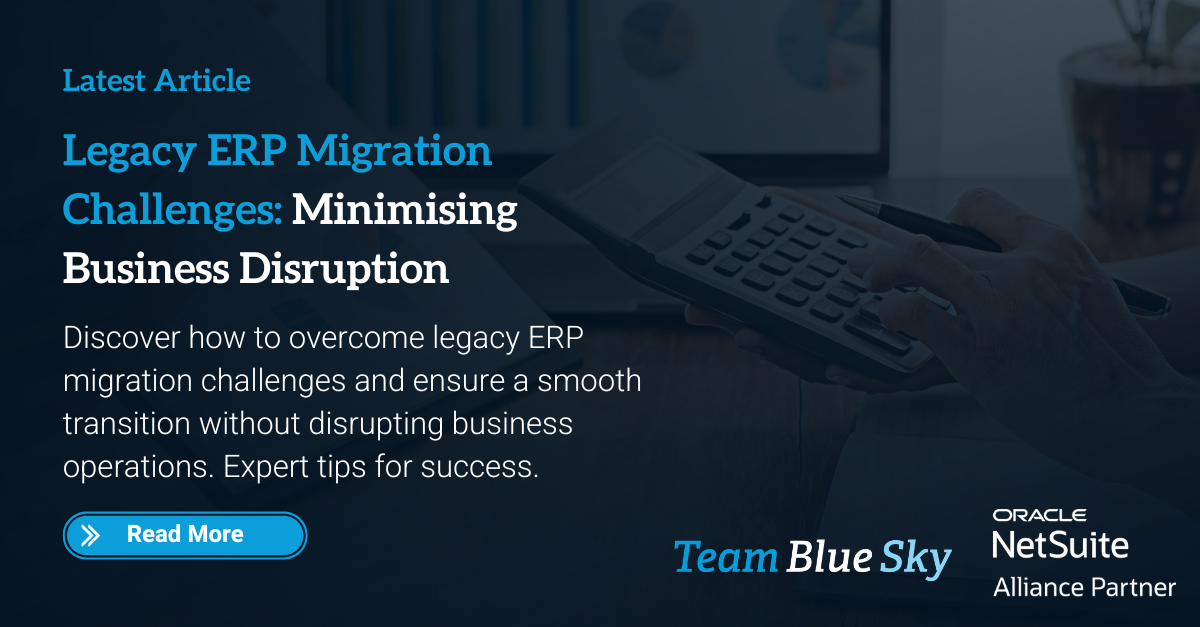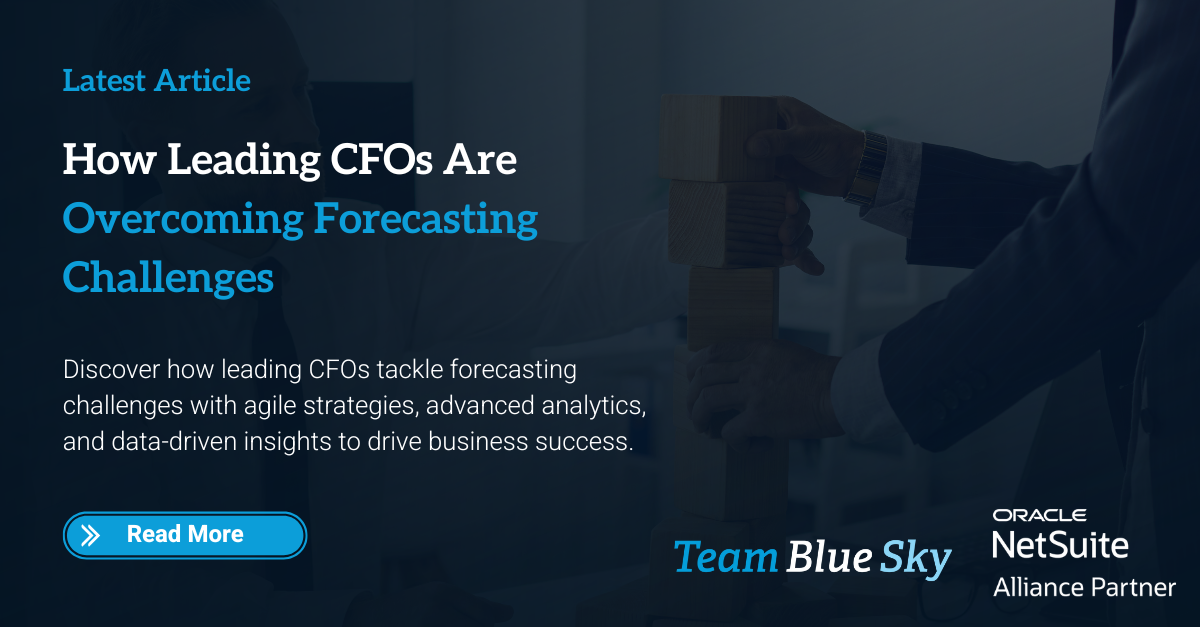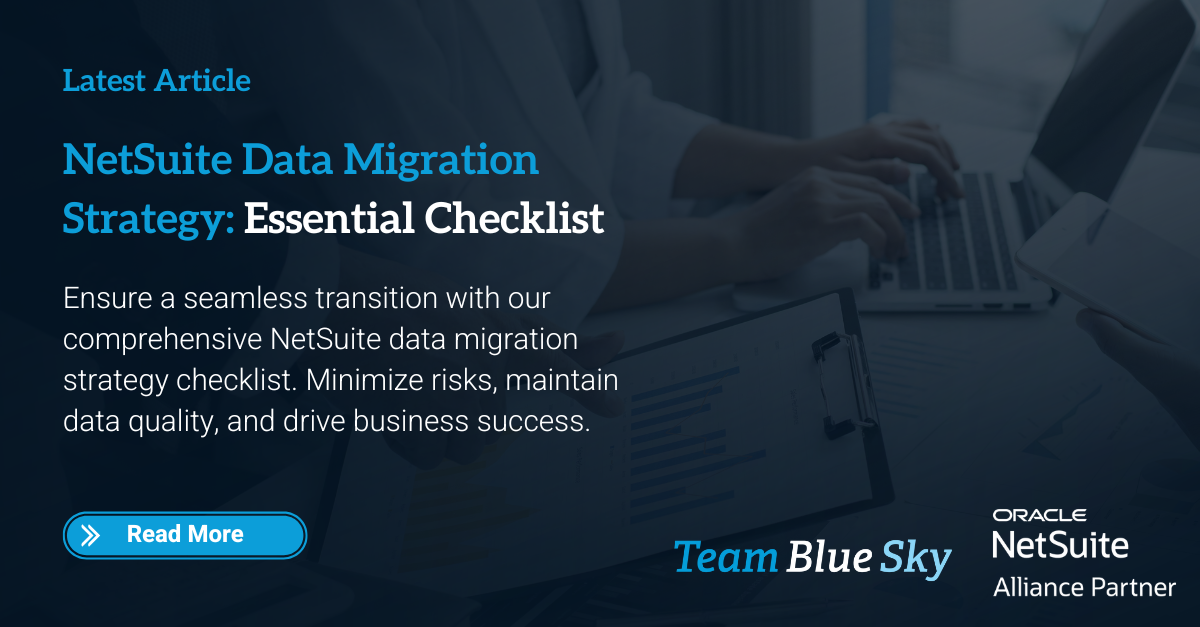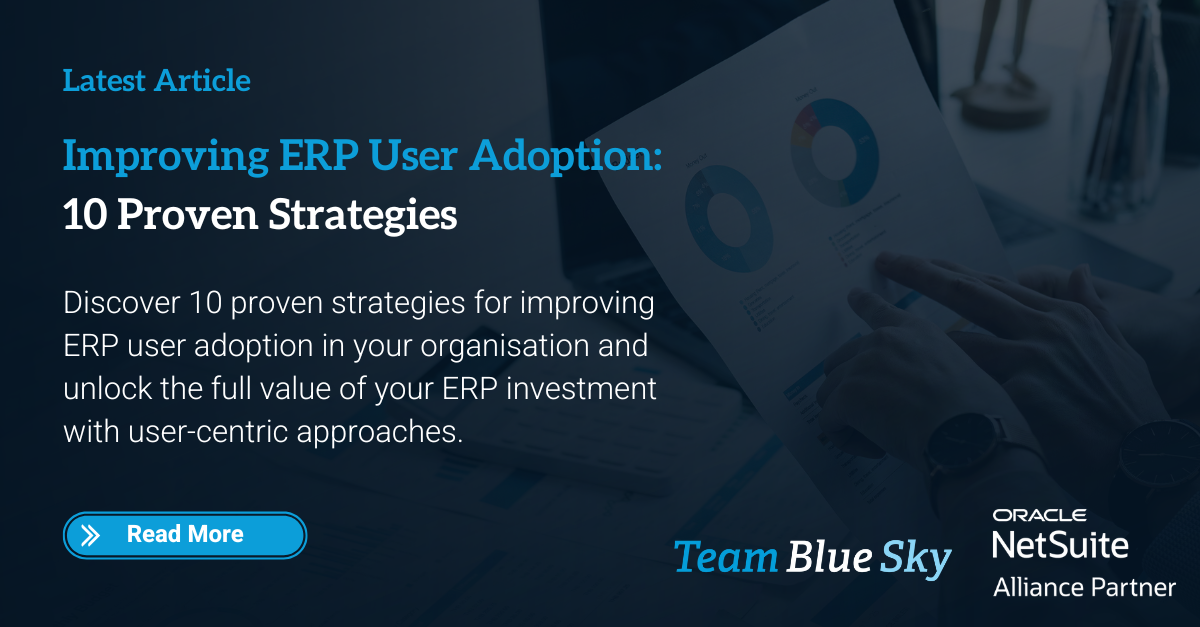Proven NetSuite Training Strategies to Empower Your Staff
Why Strategic Training is Non-Negotiable During a NetSuite Implementation
The implementation of an Enterprise Resource Planning (ERP) system like Oracle NetSuite represents one of the most significant technological and financial undertakings an organisation can pursue. It promises a future of streamlined operations, real-time data visibility, and enhanced decision-making. However, the realisation of these benefits is not guaranteed by the software alone.
The ultimate success or failure of a NetSuite investment hinges on a single, critical variable: the people who use it every day. This report establishes the unassailable business case for a comprehensive, strategic approach to NetSuite training. It reframes training not as a peripheral line-item expense, but as a primary driver of return on investment (ROI) and a crucial risk mitigation strategy for the entire digital transformation initiative.
By moving beyond basic functional instruction to a holistic program of user empowerment, organisations can unlock the full, transformative potential of their NetSuite platform.
Linking Training to User Adoption and the Impact on ERP ROI
A NetSuite implementation is, at its core, a business transformation project. As such, it is subject to the same pressures and risks that govern all large-scale organisational change. Research indicates that a staggering 70% of these transformation projects fail to achieve their stated objectives, with the primary cause being resistance to change and low user adoption.
When employees do not understand, trust, or effectively utilise a new system, even the most powerful and feature-rich ERP platform devolves into a mere sunk cost, its potential for value creation left dormant. The costs of this gap between technological capability and human adoption are steep and multifaceted, rippling through the organisation in the form of reporting errors, compliance headaches, and lost productivity.
The direct causal link between effective training, user adoption, and financial return is therefore undeniable. A well-planned training program is the mechanism by which an organisation maximises its ROI, equipping teams with the skills they need to leverage the full breadth of the platform's capabilities.
Without this enablement, the investment remains perpetually underutilised. Conversely, when training is prioritised, it drives the active usage and adoption across departments necessary to unlock the measurable ROI that leadership envisioned at the project's inception.
The financial impact of successful, training-led adoption is not merely theoretical. It is demonstrated by quantifiable results from companies that have navigated this process. A landmark case study of RedBuilt, a manufacturer of engineered wood products, reveals the profound financial returns of a well-executed NetSuite deployment.
The company achieved a remarkable 158% ROI with a payback period of just under six months (0.47 years). This return was not driven by abstract efficiencies but by concrete, measurable business outcomes directly tied to the successful use of the system:
Headcount Reallocation
The integration of ERP and CRM functions within NetSuite eliminated the need for manual data transfer between systems, allowing for the reallocation of three full-time data-entry administrators.
Operational Cost Reduction
The time required to build and maintain critical reports was reduced by 50%. By empowering end-users to perform this work, the company reduced its reliance on costly specialised programmers, resulting in a net 75% reduction in report-building costs.
Direct Cost Avoidance
By migrating to NetSuite, RedBuilt avoided a one-time fee of $400,000 from its previous vendor, SAP, to maintain support.
Productivity Gains
The 52 end-users of the system realised an estimated 5% improvement in productivity due to easier access to data and more efficient reporting capabilities.
This evidence is corroborated by other business cases. Grover Gaming, a software development company, automated over 80% of its manual business processes and achieved its NetSuite ROI faster than anticipated. Similarly, Lucira Health, a medical technology company, realised an "exponential ROI" following its implementation. A comprehensive analysis by IDC projects that the average NetSuite deployment yields a three-year ROI of 327% with a payback period of just nine months, driven by enhanced staff efficiencies and improved business results.
This body of evidence leads to a critical strategic conclusion. The primary risk in an ERP project is not technical failure but human failure—the failure of the organisation to adopt and embrace the new system. The benefits that drive ROI are contingent on users effectively interacting with the platform to generate accurate data, streamline processes, and extract valuable insights. Therefore, the budget allocated for training should not be viewed as a simple operational expense.
It is a strategic financial instrument, a form of insurance that protects the far larger capital investment in the NetSuite software and implementation. The cost of a world-class training program is a small fraction of the potential financial loss from a failed implementation or the vast unrealised gains from a perpetually underutilised system. This reframes the entire budgetary conversation, positioning training as an indispensable component of financial risk management for the project.
Section 1.2: Beyond Functionality: The Pillars of User Empowerment
True success with NetSuite is achieved when users are not merely trained but are genuinely empowered. Empowerment signifies a critical transition: employees move from being passive operators performing rote data entry to becoming proactive problem-solvers who leverage the system to improve their own work and drive the company's performance. Disempowerment, conversely, manifests in clear and costly symptoms that quietly drain productivity and stall transformation efforts. These warning signs include teams actively bypassing NetSuite in favor of outdated manual workarounds, a high volume of IT support tickets for basic "how-to" tasks, and the persistence of "shadow processes" conducted in spreadsheets and other disconnected tools.
A strategic training program is the primary vehicle for fostering user empowerment, which is built upon several foundational pillars that directly contribute to critical business outcomes:
Enhanced Data Accuracy
Empowered users understand the importance of correct data management. Training that covers not just the "how" but the "why" of data entry leads to more accurate reporting and, consequently, better business decision-making. When training is poor, the result is "dirty data," which can lead to "disastrous business decisions" and fundamentally undermines the value of the ERP.
Improved Operational Efficiency
Confident, well-trained users navigate the platform more efficiently, perform tasks more quickly, and make fewer errors. This significantly reduces the need for costly rework and allows for the automation of repetitive tasks, streamlining core business processes like order-to-cash and procure-to-pay.
Superior Decision-Making
NetSuite provides powerful analytics and reporting capabilities. An empowered user is trained to move beyond simple data entry and learn how to create and customise reports, use analytics tools, and interpret data to make informed, strategic decisions that fuel business growth.
Strengthened Compliance and Security
Proper training is crucial to ensure that employees understand and comply with internal security protocols and external regulatory requirements. This maintains data integrity and centralises security within the ERP, mitigating significant business risk.
Increased Productivity and Job Satisfaction
An intuitive and personalised training experience reduces user frustration and builds confidence. When employees feel competent and comfortable with the tools they use daily, it leads to higher productivity and greater job satisfaction. Indeed, 59% of employees report that effective training directly boosts their overall job performance.
The relationship between training, user behavior, and business outcomes creates a powerful feedback loop that can spiral in one of two directions. Understanding these dynamics is crucial for any leader overseeing a NetSuite implementation.
The Vicious Cycle of Disempowerment begins with inadequate, generic training. This leads to a lack of user confidence and a sense of frustration with the new system. To cope, employees revert to familiar manual workarounds and shadow processes, creating data silos outside of NetSuite. This parallel activity corrupts the data within the ERP, rendering its reports and dashboards unreliable. When leadership reviews this inaccurate data, they lose faith in the system's ability to provide a single source of truth. This perceived failure of the system validates the users' decision to stick with their workarounds, cementing a culture of low adoption and ensuring the project fails to deliver its promised ROI.
Conversely, the Virtuous Cycle of Empowerment is initiated by strategic, role-based training that is tailored to the user's specific responsibilities. This builds genuine confidence and competence. Users engage with the system effectively and accurately, which populates NetSuite with high-quality, trustworthy data. This clean data, in turn, fuels powerful, real-time reports, dashboards, and KPIs that leadership can rely on for strategic decision-making. Seeing tangible value, leadership is encouraged to further invest in system optimisation and continuous learning initiatives. Users feel successful and empowered, which drives deeper adoption, encourages the exploration of advanced features, and fosters a data-driven culture throughout the organisation. It is this virtuous cycle that ultimately maximises the long-term ROI of the NetSuite investment.
The Blueprint – Designing a World-Class Training Program
A successful NetSuite training initiative is not an accident; it is the product of a deliberate and meticulously designed strategy. This blueprint provides a detailed, actionable framework for constructing such a program, moving from high-level strategic alignment to the granular details of curriculum architecture and delivery. It is founded on the principle that effective training begins long before the first session, is tailored to the precise needs of each user, and leverages a sophisticated blend of learning methodologies to maximise engagement and retention.
Pre-Implementation Strategy: The Training Needs Assessment (TNA)
The foundation of any effective training program is a comprehensive Training Needs Assessment (TNA). This critical discovery phase, conducted long before go-live, serves to align training objectives with the overarching strategic goals of the business and the operational realities of its employees. A TNA prevents the common pitfall of designing training based on assumptions, ensuring that the final program is relevant, targeted, and impactful. A robust TNA framework for a NetSuite implementation consists of four key stages.
Define Strategic Objectives
The process must begin with a clear understanding of the desired business outcomes. The TNA is not an academic exercise; it is a tool to help the business achieve its goals. Therefore, the first step is to collaborate with senior leadership to define the clear, measurable objectives for the NetSuite implementation. These are not vague aspirations but concrete targets, such as reducing inventory waste by 15%, improving cash flow visibility to predict needs 60 days out, or automating 80% of the accounts payable process. This crucial first step ensures that every subsequent training activity is directly linked to a tangible business strategy.
Conduct an Organisational and Process Audit
With the strategic goals defined, the next step is to map the current state of the organisation's processes. This involves a thorough audit of existing business workflows to identify bottlenecks, inefficiencies, and areas ripe for automation. Critically, this audit must go beyond documented procedures to actively seek out and measure "shadow processes"—the unofficial workarounds, spreadsheets, and manual methods that employees use to get their jobs done. These shadow processes are often a response to the limitations of legacy systems and represent the true, on-the-ground reality of how work is accomplished. Uncovering them through surveys, interviews, and direct observation is essential for bridging the gap between formal process maps and the way employees actually work.
Perform a User and Role Analysis
A one-sise-fits-all training approach is destined to fail. The TNA must include a detailed survey of the individual roles and responsibilities of every user who will interact with NetSuite, from senior executives who may only view dashboards to warehouse staff who will use the system all day. This analysis should assess current skill levels, overall technology readiness, and any prior ERP experience. This segmentation allows for the creation of differentiated learning paths that meet users where they are, preventing the dual problem of overwhelming beginners while boring experienced users.
Conduct a Gap Analysis
The final stage of the TNA is to synthesise the findings from the previous steps. By comparing the desired future state (the strategic objectives enabled by NetSuite) with the current state (the existing skills and processes), the organisation can identify the precise knowledge, skills, and abilities (KSAs) that are missing. This gap analysis forms the explicit foundation of the training curriculum, defining exactly what needs to be taught to whom.
With the learning gaps clearly identified, the organisation can then develop SMART (Specific, Measurable, Achievable, Relevant, Time-bound) objectives for the training program itself. This framework transforms vague training goals into actionable, trackable projects. For instance, a generic goal like "Train the finance team" becomes a powerful SMART objective:
"By the end of the second quarter (Time-bound), 100% of the Accounts Payable team (Specific) will be able to process vendor bills in NetSuite from creation to approval without assistance (Achievable). Success will be measured by a 90% reduction in 'how-to' support tickets related to bill entry and a 98% data accuracy rate on all new bill records, as validated by audit reports (Measurable). This objective directly supports the corporate goal of accelerating the monthly financial close cycle (Relevant).".
Ultimately, the TNA serves a critical dual purpose that extends beyond just planning for training. Its first function is to inform the training curriculum by identifying the specific skill gaps that need to be addressed. Its second, and arguably more strategic function, is to inform the system configuration itself. The discovery of shadow processes and real-world workflows during the TNA provides invaluable feedback to the technical implementation team. This feedback loop allows the team to adjust NetSuite's configuration before go-live to better align with the practical needs of the end-users. This proactive alignment prevents a fundamental disconnect between the system and its users, which is a primary cause of adoption failure. The TNA, therefore, acts as a vital bridge between the technical project team and the human organisation, making it one of the most pivotal steps in the entire implementation lifecycle.
The Curriculum Matrix: Role-Based Training Architecture
The effectiveness of NetSuite training is directly proportional to its relevance. Generic, one-sise-fits-all training programs fail because they do not speak to the specific, daily realities of the user. A successful curriculum architecture is therefore built on the principle of role-based training, delivering highly tailored content that is directly applicable to a user's unique tasks and responsibilities within the organisation.
This approach must be fundamentally grounded in NetSuite's own role-based architecture. A user's experience in NetSuite is entirely governed by their assigned Role and its associated Center Type. The Center Type dictates the entire user interface, including the layout of the dashboard, the available navigation menus, and the Key Performance Indicators (KPIs) that are displayed. This makes it imperative to avoid the use of "catch-all" or "blended" roles that combine disparate job functions (e.g., adding accounting permissions to a sales role). Such roles create confusing and unintuitive user interfaces, limit visibility into key data, and can grant users access to functionality they have not been trained on. Properly segmenting roles based on distinct job functions is therefore a critical prerequisite for designing and delivering effective role-based training.
The following detailed curricula provide a blueprint for training four key user personas, integrating best practices and specific topics identified across a wide range of expert sources.
A) Executive & Leadership (CFO, CIO, VP of Operations) Curriculum:
Primary Focus
The goal for this group is not transactional proficiency but strategic oversight, performance monitoring, and data-driven decision-making. They need to understand how to consume information from NetSuite, not how to input it.
Key Modules & Functionalities
Training should center on NetSuite's powerful analytical tools. This includes Financial Reports and Standard KPIs , the creation and interpretation of SuiteAnalytics Workbooks, and the Personalisation of Dashboards to display the most relevant, real-time metrics. For organisations with multiple entities, an overview of Global Consolidation within NetSuite OneWorld is essential. Executives should also be trained on Goal Tracking with Performance Metrics to monitor strategic initiatives directly within the system. A high-level overview of core business process flows (e.g., Order-to-Cash, Procure-to-Pay) provides context for the data they are viewing.
Learning Objective
To empower executives to independently access and interpret real-time business performance data via their dashboards and reports, enabling them to make faster, more informed strategic decisions.
B) Project & Implementation Manager Curriculum:
Primary Focus
This curriculum is designed for the individuals responsible for managing the NetSuite implementation project itself, as well as any future projects within the NetSuite ecosystem.
Key Modules & Functionalities
The core of this training is Project Management Essentials. This includes modules on Project Creation, Project Templates, and Project Budgeting to ensure projects are set up for success from the start. It covers Task Assignment and Resource Allocation to manage team workload effectively, and Time and Expense Management for tracking project costs and approvals. Crucially, this curriculum must also include training on Project Monitoring and Reporting to track progress against baselines , as well as the principles of Change Management and Communication Planning to manage the human side of the project. Learning Objective: To equip project managers with the tools and knowledge to effectively plan, execute, monitor, and report on projects within NetSuite, ensuring they are delivered on time and within budget.
C) Super User & Administrator Curriculum:
Primary Focus
This is the most intensive curriculum, designed to create in-house experts who can perform system maintenance, configuration, optimisation, and provide first-line support to other users.
Key Modules & Functionalities
This training is multifaceted and covers a broad range of technical and administrative topics.
Core Administration: This includes User and Role Management, with a deep dive into permissions and access controls ; Data Management, covering CSV imports, data cleansing best practices, and ongoing data governance ; and management of customisations via SuiteBundler. They must also learn to conduct System Health Checks and use performance monitoring tools.
Customisation & Automation: Training must cover the creation of Custom Fields, Forms, Records, and Transactions to tailor the system to unique business needs. A critical component is process automation using SuiteFlow, covering both fundamental and advanced workflow creation.
Advanced Topics: Super users should receive an introduction to SuiteScript to understand the possibilities of scripting, even if they are not developers. They should also be familiar with the SuiteCloud Development Framework (SDF) for managing customisations and understand how to use Security and Audit Trails to ensure system integrity.
Certifications: The training path for this group should be explicitly aligned with official NetSuite certifications, particularly the SuiteFoundation and NetSuite Certified Administrator exams, to provide a clear goal and validate their expertise.
Learning Objective: To cultivate a team of internal NetSuite experts capable of independently managing, customising, and troubleshooting the NetSuite instance, thereby reducing reliance on external consultants and empowering the entire user base.
D) End-User Curriculum (by Business Function):
- Primary Focus: This training must be intensely practical, focusing on the efficient and accurate execution of daily, role-specific tasks. The guiding principle is the "day-in-the-life" scenario, where training directly mirrors the user's actual job functions.
- Key Modules & Functionalities (by Department):
- Finance & Accounting: Training will cover the full accounting cycle within NetSuite, including Accounts Payable (creating vendor bills, processing payments), Accounts Receivable (creating invoices, applying customer payments), General Ledger (making journal entries), Bank Reconciliation, and the Period-End Close process.
- Sales & CRM: Users will be trained on the end-to-end sales process, including Lead and Opportunity Management, creating Quotes and Sales Orders, and managing customer support inquiries through Case Management.
- Operations & Supply Chain: This curriculum focuses on the physical flow of goods, covering Inventory Management (item record setup, inventory costing methods), Demand Planning to forecast needs, the complete Order Fulfillment process (picking, packing, shipping), and Purchase Order Management for procurement.
- Learning Objective: To enable every end-user to perform all of their required job functions within a single, well-defined NetSuite role with maximum speed, accuracy, and confidence.
To translate this architecture into an actionable planning tool, the following matrix is indispensable. It converts the abstract concept of role-based training into a concrete guide, ensuring relevance and providing a clear communication tool for all project stakeholders.
| User Persona | Primary Goal | Key NetSuite Modules | Essential Reports & KPIs | Recommended Training Topics/Courses |
|---|---|---|---|---|
| Executive & Leadership | Strategic oversight and data-driven decision-making | Financials, SuiteAnalytics, OneWorld (if applicable) | KPI Scorecards, Financial Statements (P&L, Balance Sheet), Sales Trend Reports, Budget vs. Actual Reports | NetSuite: Financial Management, SuiteAnalytics: Reports and Searches, Harnessing the Power of NetSuite's Dashboards |
| Project Manager | On-time, on-budget project delivery and management | Project Management, Services Resource Planning (SRP) | Project Profitability, Resource Utilisation, Project Budget vs. Actual, Project Milestones | Project Management Essentials, Time and Expense Management, Project Billing, Change Management Best Practices |
| Super User / Administrator | System configuration, maintenance, optimisation, and user support | SuiteCloud Platform (SuiteFlow, SuiteBuilder), User/Role Management, Data Management | Login Audit Trail, System Performance Monitor, Saved Search of Customisation Changes, Data Quality Dashboards | SuiteFoundation, NetSuite: Administrator Fundamentals, SuiteFlow: Workflow Fundamentals, CSV Imports, Security & Audit Best Practices |
| End-User: Finance | Accurate and efficient execution of accounting tasks | Accounts Payable, Accounts Receivable, General Ledger, Banking | AP Aging, AR Aging, Trial Balance, Bank Reconciliation Summary | Using Accounts Payable (AP), Using Accounts Receivable (AR), Using General Ledger (GL), Period-End Close Best Practices |
| End-User: Sales | Manage sales pipeline and process customer orders | Customer Relationship Management (CRM), Sales Force Automation | Sales Pipeline by Rep, Forecast vs. Quota, New Leads Report, Sales by Item | Using CRM, Sales Force Automation: Fundamentals, Order to Cash Process Flow |
| End-User: Operations | Manage inventory, fulfillment, and procurement | Inventory Management, Order Management, Purchasing | Inventory Turnover, On-Time Delivery Rate, Purchase Order History, Item Demand Plan | Inventory Item Costing, Demand Planning, Procure to Pay Process Flow |
Delivery Methodologies: Crafting a Blended Learning Experience
Defining what to teach is only half the battle; how the training is delivered is equally critical to its success. A single training modality is insufficient to meet the needs of a diverse workforce with varying learning styles, schedules, and levels of technical acumen. The most effective strategy is a blended learning approach, which thoughtfully combines different delivery methods to create a flexible, engaging, and comprehensive learning experience. This requires a careful analysis of the available methods and a strategic decision on when to leverage NetSuite's native resources versus engaging third-party experts.
A Comparative Analysis of Core Delivery Methods:
- Instructor-Led Training (ILT) and Virtual Instructor-Led Training (VILT):
- Strengths: This traditional classroom format, whether in-person or virtual, excels in fostering interaction. It provides a forum for immediate questions and answers, allows instructors to provide real-time, personalised feedback, and is ideal for facilitating complex, collaborative problem-solving exercises and group discussions. The virtual format (VILT) delivers these benefits while eliminating travel costs and logistical complexities, making it a highly efficient option.
- Weaknesses: ILT is the most expensive delivery method per user and is difficult to scale across a large or geographically dispersed organisation. Its effectiveness can also be subject to the inconsistency of different instructors, and it requires employees to block out significant time away from their daily tasks.
- Strategic Application: Best suited for initial project kick-offs, deep-dive workshops on complex, process-heavy topics (like a financial period-end close), and any training that requires significant team collaboration.
- Self-Paced eLearning:
- Strengths: eLearning offers unparalleled flexibility and scalability. It allows users to learn at their own pace and on their own schedule, which minimises work disruptions. The messaging is perfectly consistent, and users can easily refer back to the material for reinforcement. Studies have shown that eLearning can lead to knowledge retention rates that are 25% to 60% higher than traditional instructor-led methods.
- Weaknesses: The primary drawback is the lack of social interaction and the asynchronous nature of feedback. There is also a significant risk of poor instructional design, resulting in "text-heavy, static" content that fails to engage the learner. This method requires a high degree of self-discipline from the employee.
- Strategic Application: Ideal for delivering foundational knowledge (e.g., basic NetSuite navigation, key terminology), reinforcing concepts taught in ILT sessions, and for compliance-related training.
- Digital Adoption Platforms (DAPs):
- Strengths: DAPs represent a paradigm shift in software training by delivering guidance in the flow of work. Instead of teaching users in a separate environment, these platforms embed contextual, step-by-step walkthroughs, self-help widgets, and proactive nudges directly within the live NetSuite interface. This approach builds muscle memory, dramatically reduces "how-to" support tickets, and accelerates the user's time-to-value by providing assistance at the precise moment of need.
- Weaknesses: DAPs are designed for task-based guidance, not for teaching deep conceptual understanding. They require an initial investment in software and the resources to create and maintain the guided content.
- Strategic Application: Exceptionally effective for onboarding new users, guiding all users through complex or infrequently performed tasks (e.g., running a year-end report), and for proactively driving the adoption of underutilised or newly released features.
Strategic Evaluation: Native vs. Third-Party Training Resources
A critical decision in developing the training plan is the extent to which the organisation will rely on NetSuite's own resources versus engaging specialised third-party consultants.
- Native NetSuite Resources (Learning Cloud Support, Guided Learning, SuiteAnswers):
- Pros: The content provided directly by NetSuite is authoritative, comprehensive, and guaranteed to be aligned with the latest product releases and best practices. The Learning Cloud Support (LCS) platform offers a vast library of on-demand courses, live webinars, and hands-on lab environments. Furthermore, NetSuite Guided Learning provides free, embedded, role-based guidance within the application, offering immediate value out-of-the-box.
- Cons: By necessity, native resources are generic. They cannot be tailored to a company's unique customisations, specific business processes, or industry-specific data and terminology. They teach how NetSuite can work, not necessarily how it does work in a specific, configured environment.
- Third-Party Training Consultants:
- Pros: The primary advantage of a third-party partner is the ability to develop a fully customised and tailored training program. These consultants can build training materials that use the client's actual NetSuite configuration, their specific business processes, and real-world "day-in-the-life" scenarios. They often bring deep, client-side experience in specific industries, which adds a layer of invaluable context. Their engagement and pricing models are also typically more flexible than bundled enterprise contracts.
- Cons: This tailored approach comes at a higher cost. The quality and expertise can also vary significantly between providers, requiring careful vetting. Additionally, third-party consultants do not have access to NetSuite's proprietary backend systems, which can limit their ability to assist with deep, platform-level troubleshooting.
To aid in these strategic decisions, the following matrices provide a clear, at-a-glance framework for selecting the right blend of delivery methods and resource types based on the organisation's specific needs and context.
| Delivery Method | Cost | Scalability | Interactivity | Retention | Best Use Case |
|---|---|---|---|---|---|
| ILT / VILT | High | Low | Very High | Moderate | Complex collaborative tasks, initial team kick-offs, deep-dive workshops. |
| Self-Paced eLearning | Low-Medium | Very High | Low | High | Foundational knowledge, pre-work for ILT, post-training reinforcement. |
| Digital Adoption Platform (DAP) | Medium | Very High | High (Contextual) | Very High (Applied) | Onboarding, real-time task guidance, driving adoption of new features. |
| Decision Factor | Native NetSuite Resources (e.g., LCS) | Third-Party Training Consultants |
|---|---|---|
| Customisation Level | Low (Generic, standard processes) | High (Tailored to specific configurations, workflows, and data) |
| Cost Structure | Often bundled in subscription (LCS Pass) or free (Guided Learning) | Typically project-based or time-and-materials; higher direct cost |
| Speed of Deployment | Immediate access to existing library | Requires development time to create custom materials |
| Alignment with Updates | Excellent (Content is always current with new releases) | Requires ongoing engagement to update materials for new releases |
| Industry Specificity | General (Covers broad best practices) | High (Can incorporate deep industry-specific context and terminology) |
The Execution – Fostering Adoption and Continuous Improvement
The final and most crucial phase of a NetSuite training strategy is its execution and sustainment. Designing an excellent curriculum is a necessary but insufficient condition for success. The true value of the investment is realised only when training is embedded within a robust change management framework, supported by a culture of continuous learning, and validated by a rigorous measurement system. This section outlines the ongoing processes required to make training stick, drive long-term user adoption, and ensure the NetSuite platform evolves in lockstep with the business it serves.
Integrating Training into a Change Management Framework
Training does not occur in a vacuum. Its effectiveness is profoundly influenced by the organisational context in which it is delivered. A well-executed change management strategy is the foundation upon which successful training is built; it prepares the organisation to be receptive to both the new system and the new ways of working it requires. Training is a critical tactic within this broader strategy, but it cannot succeed alone.
A structured change management model, adapted from established best practices, provides a roadmap for navigating the human side of a NetSuite implementation.
1. Define and Communicate the Change
The process begins with absolute clarity. Leadership must consistently and transparently articulate the "why" behind the move to NetSuite—the strategic rationale, the anticipated benefits for the company and for individual employees, and the expected impact on specific roles and processes. This communication must be continuous, using multiple channels to build trust, alleviate skepticism, and proactively address the natural resistance to change.
2. Engage Stakeholders and Appoint Champions
User buy-in is not achieved through proclamation; it is earned through participation. It is imperative to involve end-users early and often in the implementation process, particularly during the requirements gathering and User Acceptance Testing (UAT) phases. This early involvement fosters a sense of ownership. A key tactic within this step is the identification and empowerment of "NetSuite Champions." These are enthusiastic and tech-savvy employees who can act as peer mentors, internal trainers, and evangelists for the new system. They serve as a crucial bridge between the technical project team and the broader user community, translating technical concepts into practical advice and building grassroots support.
3. Develop and Execute the Plan
The formal change management plan must have the multifaceted training program as one of its central pillars. The execution of this plan should consider a phased rollout of NetSuite modules or functionalities. Instead of a disruptive "big bang" go-live, a phased approach allows employees to adapt to changes gradually, which minimises operational disruption, builds confidence, and improves user adoption rates.
4. Establish Robust Feedback Loops
The change process must be a two-way street. Mechanisms such as UAT sessions, post-training surveys, and departmental focus groups should be used not only to test the system's functionality but also to gather candid feedback on the training content and delivery methods. This feedback is invaluable, allowing the project team to make iterative improvements to both the system configuration and the training program, ensuring they better meet the needs of the users.
5. Embed and Reinforce the Change
The work of change management does not end at go-live. There is a natural tendency for employees to revert to familiar, albeit inefficient, old habits. To counteract this, the organisation must actively work to embed the new processes into the company culture. This can be achieved by aligning performance metrics, reward systems, and recognition programs with the effective use of NetSuite. When employees see that proficiency in the new system is valued and rewarded, it powerfully reinforces the desired behaviors and sustains the change for the long term.
Building a Continuous Learning Culture & Center of Excellence (CoE)
A one-time training event at the time of implementation is fundamentally insufficient for a dynamic, cloud-based platform like NetSuite. With two major releases each year that introduce new features and enhance existing functionality, knowledge quickly becomes obsolete. To protect the long-term value of the NetSuite investment, the organisation must commit to fostering a culture of continuous learning. This culture is best institutionalised and governed through the establishment of a formal NetSuite Center of Excellence (CoE).
Strategies for Fostering a Continuous Learning Culture
Leverage NetSuite's Learning Ecosystem: Organisations should actively promote and integrate NetSuite's own extensive continuous learning resources. This includes providing key users with the NetSuite Learning Cloud Support (LCS) Pass, which offers ongoing, on-demand access to a vast catalog of eLearning courses, hands-on labs, and live expert-led webinars. Employees should be trained to use SuiteAnswers as their first stop for self-service support, as it contains a comprehensive knowledge base of articles, help topics, and training videos.
Build an Internal NetSuite Support Team
Establish Internal Learning Programs: The organisation should supplement NetSuite's resources with its own. This includes conducting regular refresher courses, hosting workshops to share best practices, and running webinars to introduce and demonstrate the functionality included in new releases.
Promote a Growth Mindset: A true learning culture starts at the top. Leadership must model a commitment to lifelong learning by embracing challenges as learning opportunities. The organisation should create programs that formally recognise and reward employees who proactively develop new NetSuite skills, perhaps through certifications or achieving "super user" status. This sends a powerful message that continuous improvement is a core company value.
Establishing a NetSuite Center of Excellence (CoE)
A CoE is the organisational structure that transforms continuous learning from a laudable goal into a systematic business function. It is a formal, cross-functional team charged with the ongoing governance, support, and strategic optimisation of the NetSuite platform. Its purpose is to ensure that the system remains aligned with the evolving needs of the business long after the initial implementation project is complete.
The core functions of a NetSuite CoE include:
Governance and Best Practices
The CoE establishes and enforces enterprise-wide policies for data quality, security protocols, user access, and the process for requesting and approving customisations. This prevents the system from becoming disorganised and ensures it remains a reliable source of truth.
Ongoing Training and Enablement
The CoE owns the continuous learning program. It is responsible for onboarding all new hires, developing and delivering training for new NetSuite releases, and maintaining the central repository of training materials and process documentation.
System Optimisation and Innovation
The CoE proactively seeks opportunities to extract more value from the platform. This includes identifying manual processes that can be automated with workflows, streamlining existing workflows for greater efficiency, and evaluating new NetSuite features or third-party SuiteApps that could benefit the business.
Stakeholder Management
The CoE serves as the central point of contact for all NetSuite-related matters. It manages the pipeline of enhancement requests from various departments, prioritises them based on business impact, and communicates system changes and updates to the entire user community.
The initial ROI calculated for an ERP implementation, such as the impressive results seen by RedBuilt, can easily degrade over time if the system is not actively managed and optimised to keep pace with the business. NetSuite is not a static asset to be implemented and forgotten; it is an evolving platform that requires continuous stewardship. A Center of Excellence provides this stewardship. It transforms the management of NetSuite from a reactive, IT-support function that simply fixes problems into a proactive, strategic business function that creates value. By continuously aligning the platform's powerful capabilities with the organisation's evolving strategic goals, the CoE becomes the engine of long-term ROI. It is the mechanism that ensures the value realised at launch is not only sustained but continues to grow for years to come, preventing the system from becoming a costly, inefficient "hairball" of unmanaged customisations and outdated processes.
Measuring Training Effectiveness: A Multi-Level KPI Framework
To justify the ongoing investment in training and to continuously improve its impact, an organisation must move beyond anecdotal feedback and implement a structured system for measuring its effectiveness. A multi-layered Key Performance Indicator (KPI) framework is required to connect learning activities to observable behavioral changes and, ultimately, to tangible business results. The Kirkpatrick Model of training evaluation provides a globally recognised, four-level framework that is perfectly suited for this purpose.
Applying the Kirkpatrick Model to a NetSuite training program provides a comprehensive, 360-degree view of its impact.
Level 1: Reaction
This level measures the immediate satisfaction of the learners. The goal is to gauge whether they found the training engaging, favorable, and relevant to their jobs.
This is typically accomplished through post-training surveys, often called "smile sheets." These questionnaires should ask participants to rate the quality of the content, the effectiveness of the instructor, the relevance of the exercises to their daily tasks, and their overall learning experience.
Level 2: Learning
This level assesses the degree to which participants acquired the intended knowledge, skills, and confidence from the training.
Learning is measured through more objective means than reaction. This includes pre- and post-training knowledge assessments or quiszes to quantify the increase in understanding. For practical skills, this involves hands-on evaluations where users are asked to perform specific tasks in a NetSuite sandbox environment. A clear scoring process must be established in advance to ensure consistency.
Level 3: Behavior
This is a critical level that measures whether the learning has transferred to the workplace. It seeks to answer the question: Are employees actually applying what they learned on the job?.
This is where the NetSuite platform itself becomes a powerful measurement tool. By creating saved searches, reports, and dashboards, the organisation can track a host of behavioral KPIs directly within the system:
User Adoption Rates: Tracking the percentage of licensed users who are actively logging in and the frequency of their sessions.
System and Feature Utilisation: Monitoring the usage of specific modules, transaction types, or new features that were the focus of training.
Process Efficiency Gains: Measuring the reduction in the time it takes to complete key tasks or cycles, such as the average time to fulfill an order or close a support case.
Data Accuracy Improvement: Tracking the reduction in data entry error rates, identified through exception reports or audit trails.
Reduction in Support Dependency: Monitoring the volume of "how-to" support tickets submitted to the help desk or internal super users. A decrease signifies greater user self-sufficiency.
Level 4: Result
The final level evaluates the impact of these behavioral changes on the business itself. It connects the training program to the organisation's highest-level strategic goals and measures its ultimate ROI.
This involves correlating the Level 3 behavioral metrics with the organisation's primary business KPIs. For example:
Financial KPIs: An improvement in data accuracy and process efficiency (Level 3) should lead to an improvement in financial metrics like Gross Profit Margin, Net Profit Margin, Operating Cash Flow, or a reduction in Days Sales Outstanding (DSO).
Operational KPIs: Increased user adoption and efficiency (Level 3) should translate into measurable improvements in operational metrics such as Inventory Turnover, Order Fulfillment Time, or Customer Satisfaction Scores.
The following dashboard provides a template for operationalising this framework, creating a single source of truth for evaluating the comprehensive impact of the NetSuite training program. This tool moves the conversation about training from a qualitative assessment to a data-driven analysis, providing the evidence needed to demonstrate its value and justify continued investment.
| Kirkpatrick Level | Key Performance Indicator (KPI) | Measurement Method / Data Source | Target / Benchmark |
|---|---|---|---|
| Level 1: Reaction | Training Satisfaction Score | Post-training survey (average rating on a 5-point scale) | > 4.5 / 5.0 |
| Perceived Relevance Score | Post-training survey question: "How relevant was this training to your daily job?" | > 90% "Highly Relevant" | |
| Level 2: Learning | Knowledge Gain Percentage | Pre- vs. Post-training assessment scores | > 85% average score improvement |
| Task Proficiency Rate | Score on a hands-on skills test in a sandbox environment | > 95% of users pass proficiency test | |
| Level 3: Behavior | User Adoption Rate | NetSuite Login Audit Trail: % of active users per month | > 90% of licensed users active |
| Data Entry Error Rate | NetSuite Saved Search: Count of transaction errors per user/department | < 2% error rate on new records | |
| Support Ticket Reduction | Help Desk System: % decrease in "how-to" tickets for trained topics | 75% reduction in relevant tickets | |
| Cycle Time for Key Process | NetSuite Saved Search: Average time from Sales Order creation to Fulfillment | 20% reduction in average cycle time | |
| Level 4: Results | Inventory Turnover | NetSuite Financial Reports | Increase from 4.0 to 5.0 annually |
| Days Sales Outstanding (DSO) | NetSuite Financial Reports | Decrease from 45 days to 35 days | |
| Financial Close Time | Manual Tracking | Reduce month-end close process from 10 days to 5 days | |
| ROI of Training Program | (Business Impact Value - Training Cost) / Training Cost | Positive ROI within 12 months |
Key Takeaways
The successful implementation and long-term value realisation of Oracle NetSuite are not foregone conclusions determined by technical prowess alone. As this analysis has exhaustively detailed, the pivotal factor is the strategic empowerment of the workforce. An investment in NetSuite is fundamentally an investment in a new way of working, and a failure to invest in the people who must adopt these new ways is the single greatest predictor of a failed project.
The evidence leads to a series of clear, actionable conclusions and recommendations for any organisation committed to maximising its NetSuite ROI:
- Reframe Training as a Strategic Investment: The conversation around training must shift from the expense column to the investment column. The cost of a comprehensive, tailored training program is insignificant when compared to the enormous cost of a failed implementation or the perpetual opportunity cost of an underutilised system. Leadership must view the training budget as a non-negotiable financial instrument that directly mitigates the primary risk—low user adoption—of the entire ERP project.
- Adopt a Lifecycle Approach to Enablement: Effective training is not a single event but a continuous lifecycle that mirrors the employee and system journey. This report has laid out a proven framework that must be followed sequentially:
- Foundation: Begin with a rigorous Training Needs Assessment (TNA) to align training with business goals and uncover real-world processes.
- Design: Develop a Role-Based Curriculum that is meticulously tailored to the specific functions and responsibilities of each user group, from executives to end-users.
- Delivery: Employ a Blended Learning Methodology, combining the interactivity of instructor-led sessions, the flexibility of eLearning, and the powerful in-the-moment guidance of Digital Adoption Platforms.
- Context: Embed the entire training initiative within a proactive Change Management Strategy that prepares the organisation for change and fosters buy-in.
- Sustainment: Commit to a culture of Continuous Learning, institutionalised through a Center of Excellence (CoE), to keep skills sharp and evolve the platform with the business.
- Validation: Implement a Multi-Level KPI Framework, such as the Kirkpatrick Model, to rigorously measure the impact of training on behavior and business results.
- Prioritise Customisation and Relevance: Generic training is ineffective. The most impactful training programs are those that are customised to the organisation's specific NetSuite configuration, its unique business processes, and its industry terminology. While NetSuite's native resources provide an excellent foundation, organisations with significant customisations or complex workflows must seriously consider partnering with third-party specialists to create a truly relevant learning experience.
- Empower, Don't Just Instruct: The ultimate goal of training is to create a virtuous cycle of user empowerment. When employees are given the knowledge, tools, and support to master the system, they become more confident, efficient, and innovative. This leads to higher-quality data, which in turn provides leadership with more reliable insights for strategic decision-making. This positive feedback loop drives deeper adoption, unlocks advanced system capabilities, and ensures the ROI of the NetSuite platform not only is achieved but continues to grow over time.
In conclusion, empowering staff through proven NetSuite training strategies is not merely a best practice; it is the strategic imperative that separates a successful digital transformation from a costly technological misstep. By embracing the principles and frameworks outlined in this report, organisations can ensure their people are fully equipped to harness the power of NetSuite, driving sustainable growth and securing a lasting competitive advantage.

Henry Sack
General Manager

With over 12 years of experience as a NetSuite implementation consultant, Henry Sack leads TeamBlueSky’s team of NetSuite and accounting experts in his role of General Manager.
TeamBlueSky is a leading Australian
NetSuite Alliance Partner whose mission is to provide critical
NetSuite BPO and
Payroll services to NetSuite clients who are wanting to simplify their
back office processes and partner with a leading
NetSuite administration expert.
TeamBlueSky have also partnered with global Suite Developer Network partners to offer local solutioning, implementation and support services for global NetSuite SuiteApps.




